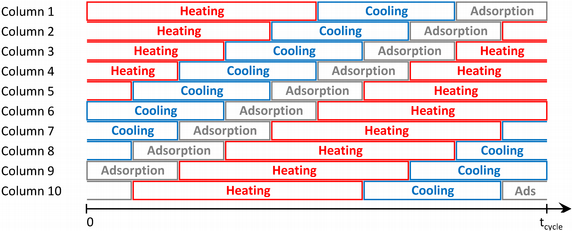Heat integration of Cyclic Adsorption Processes
Temperature swing adsorption (TSA) has been considered as an interesting option for CO2 capture from flue gases particularly in the light of the potential utilization of low-grade heat for regenerating the fixed beds, which must be performed with indirect heating in order to reach the desired CO2 purities. For moderate CO2 recovery, as required in industrial plants, the sensible heat contained in the flue gas makes up a significant amount of the heat required for the regeneration (e.g. for 12% mol CO2 in the feed and 30% CO2 recovery, an efficient heat integration in which the flue gas temperature is decreased by 120°C corresponds to 2.3MJ/kg CO2 : almost two thirds of the needed 3–4MJ/kg CO2 thermal energy for a TSA separation [1]).
At the separation process laboratory (SPL) we have a solid understanding of the process, and we possess the necessary tools in order to accurately simulate the cycle and obtain temperature, pressure, composition profiles within the column, as well as heating and cooling duties. In order to ensure continuous feed and production and mimic a continuous process, scheduling with a given number of columns is performed (Figure 1). The simultaneous heating and cooling of several columns can allow to efficiently recover heat. We have identified two strategies (Figure 2), (i) internal heat recovery between the columns that must be heated and those that must be cooled, (ii) heat recovery from a continuous low-grade heat source, such as the flue gas itself can be made more efficient by simulating a counter-current operation if several columns are being heated at the same time in a shifted way.
